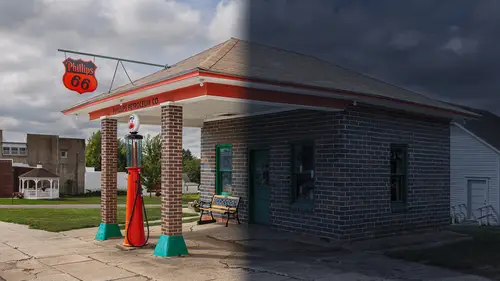
Lessons
Lesson Info
Introduction
Hey there. Let's talk about converting a daylight scene into something that looks like it might've been captured at night. This is something that is done all the time when it comes to video, because when you shoot at night, it's really hard to get detail and not get an overly noisy looking image or just be able to get nice lighting on people without having to spend a lotta money to light. Well, here we're gonna be doing it with a still photograph, but you could just as easily apply this to video. If you did it to video, it would be known as color grading. And photographers these days seem to like to use that term. The main thing is, with video, color grading is something that can be applied at 30 frames per second without slowing down any process. With Photoshop, it doesn't have to be called color grading. It just means you're manipulating the look of your picture. And if you can save it as something known as a lookup table, then it could be loaded into video gear to make it apply on m...
onitors and other things as a color grade, which makes it so somebody, let's say you're shooting during the daytime, director can be looking at a little screen that has a LUT being applied, and they're seeing it as if it looks like nighttime. Because they're able to save it in a format that can be loaded into video devices and applied in real time. But for us, we're working with stills, so color grading is not a word that I would typically use, but it seems to be the word of the day when it comes to photographers and sounding like it's cool or something. So anyway, let's dive in and get started. So first off, we have to think about nighttime. If you're out and it's within about 30 to 45 minutes of the sun going down, you should end up with a blue sky. And so a lot of color grades that end up making things look like nighttime will make it look as if it has this blueish look. If you go an hour after sunset, then the sky's gonna turn solid black. And there wouldn't be as much influence of the color of that sky. But a lot of people think of moonlit scenes as being blueish, and a lotta that has to do with watching movies where they shoot a scene during the daytime and try to make it look like nighttime. And in the process, they're trying to give it this blueish feeling. So I'm gonna give it this blueish feeling, because a lotta people think of that as nighttime. So let's close off the image on the left and let's look at what kind of images will work best for this kind of technique. Well, in fact, before I close this, if you look at both of these images and you look at the shadows in the image, you'll notice that there's not really distinct shadows where you can tell where the light source is, unless the light source is in the picture itself. Like right over here, there's a light source, and therefore, I can see the shadows that it is casting. But if those light sources were turned off, then we'd end up not really having those. So if I close out that image, an image like this one would be appropriate to make it look like it's nighttime. Because if you look at it, the shadows within the image are not really crisply defined. And it's hard to tell exactly where the light source is. And that's the case when you have an overcast sky. Overcast sky images, they're relatively easy to make them look like they were captured at night. But if, on the other hand, you have something more like this image, this is going to look more fake. And the reason for that is, if you have clouds in the sky and areas of the clouds are close to solid white, it's just not gonna look like nighttime when you end up darkening it up. Also, notice the really crisp, defined shadows in this image that really tell you where the light source is. If you were to draw a straight line from this edge to the edge that is causing the shadow, which would be the edge of the roof, it would tell you what direction the light source is in. And it's right above. This is taken around noontime. I can tell you, if you look at just this little top, this triangle, and compare it to the triangle that's actually casting it, the sun is right up here. Well, the only time we're gonna get things anywhere close to that is if it's a full moon. And in a full moon, we're still not gonna be getting quite this kinda contrast in our sky. So this would be a less than ideal image. So I'm gonna close it out. And let's close this image as well. And let's start with this one.